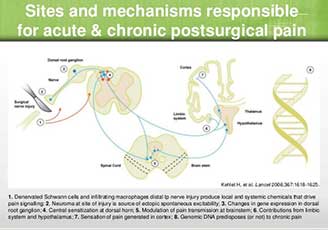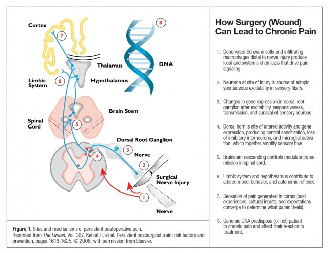Chronic post-surgical pain is defined as pain that develops after surgery and lasts for more than two months. To be diagnosed as such, other possible causes of pain have to be excluded, namely any conditions preceding the surgery.
A surgical incision produces tissue injury, inflammation, and, consequently, pain. Acute post-surgical pain is therefore a normal physiological response to the damage induced to tissues. However, this pain should subside after healing is complete. But this is not always the case. In many patients, chronic pain ensues. Some patients may actually be pain-free or have only mild pain in the acute post-surgical period, with more intense pain developing only weeks or even months after surgery.

The development of chronic post-surgical pain is attributed to changes in the peripheral and central nervous system arising as a consequence of nerve injury and/or inflammation.
Thoracic surgeries including thoracotomy or mastectomy are some of the highest risk procedures in what concerns chronic post-surgical pain. This may be due to the fact that extensive nerve damage is frequent in thoracotomy, and occasionally reported in mastectomy. Chemotherapy and radiotherapy can also induce neuropathic pain, which may also explain the high incidence of chronic pain after mastectomy.
Anyone who undergoes a major surgery is potentially at risk of developing chronic post-surgical pain. Epidemiological studies show widely variable prevalence estimates. On average, between 10 and 30% of patients who undergo common surgical procedures report persistent or intermittent pain of varying severity one year after surgery. The rate is higher for major thoracic surgeries: up to 40% of patients may develop chronic pain. Pain can be severe, or even disabling, in 5 to 10% of patients.

There are a few risk factors that may predict the development of chronic post-surgical pain. The presence of pre-surgical pain is often associated with the development of post-surgical pain; age may also contribute, since younger patients seem more prone to develop post-surgical pain; genetic predisposition and psychological factors, such as anxiety, vulnerability or resilience, can also determine the susceptibility to developing post-surgical pain.
The procedure itself is also a key determinant of the likelihood of developing post-surgical pain, specifically the surgical technique, the type of anesthesia, the inflammatory response to tissue damage, and possible nerve damage during surgery, which may result from transection, stretching, contusion, crushing, entrapment or compression of nerves, for example.
Overall, the development of chronic post-surgical pain is most likely due to a combination of these factors.
Chronic post-surgical pain usually lasts for more than 3 to 6 months after surgery. It may be the result either of unresolved inflammation or of neuropathy due to nerve injury induced by the surgery.
Immediately after surgery, there may be pain and increased sensitivity to movement and touch at the site of surgery and at the tissues surrounding it. If nerve injury occurred during surgery, neuropathic pain may develop. Features of neuropathic pain include sensory abnormalities, increased reaction to painful stimuli (hyperalgesia), and pain in response to previously non-painful stimuli, such as touch (allodynia). This is observed in most patients with chronic post-surgical pain. The intensity of chronic pain will also depend on the who gets it.

Anyone who undergoes a major surgery is potentially at risk of developing chronic post-surgical pain. Epidemiological studies show widely variable prevalence estimates. On average, between 10 and 30% of patients who undergo common surgical procedures report persistent or intermittent pain of varying severity one year after surgery. The rate is higher for major thoracic surgeries: up to 40% of patients may develop chronic pain. Pain can be severe, or even disabling, in 5 to 10% of patients.
There are a few risk factors that may predict the development of chronic post-surgical pain. The presence of pre-surgical pain is often associated with the development of post-surgical pain; age may also contribute, since younger patients seem more prone to develop post-surgical pain; genetic predisposition and psychological factors, such as anxiety, vulnerability or resilience, can also determine the susceptibility to developing post-surgical pain.
The procedure itself is also a key determinant of the likelihood of developing post-surgical pain, specifically the surgical technique, the type of anesthesia, the inflammatory and any nerve damage during surgery. Overall, the development of chronic post-surgical pain is most likely due to a combination of these factors.
Although post-surgical pain is predominantly felt at and around the site of injury, when it becomes chronic it may radiate to more distal tissues. Post-thoracotomy and post-mastectomy pain may be felt in the chest, arm, axilla and shoulder regions. The pain is primarily described as tenderness, tightness, pulling/dragging sensations and numbness, but it is also commonly felt as burning or stabbing pain.



This information is for educational purposes only and is NOT intended to replace the care or advice given by your physician. Always seek the advice of your physician or other qualified health provider before starting any new treatment or with any questions you may have regarding a medical condition. For more information see our Medical Disclaimer.